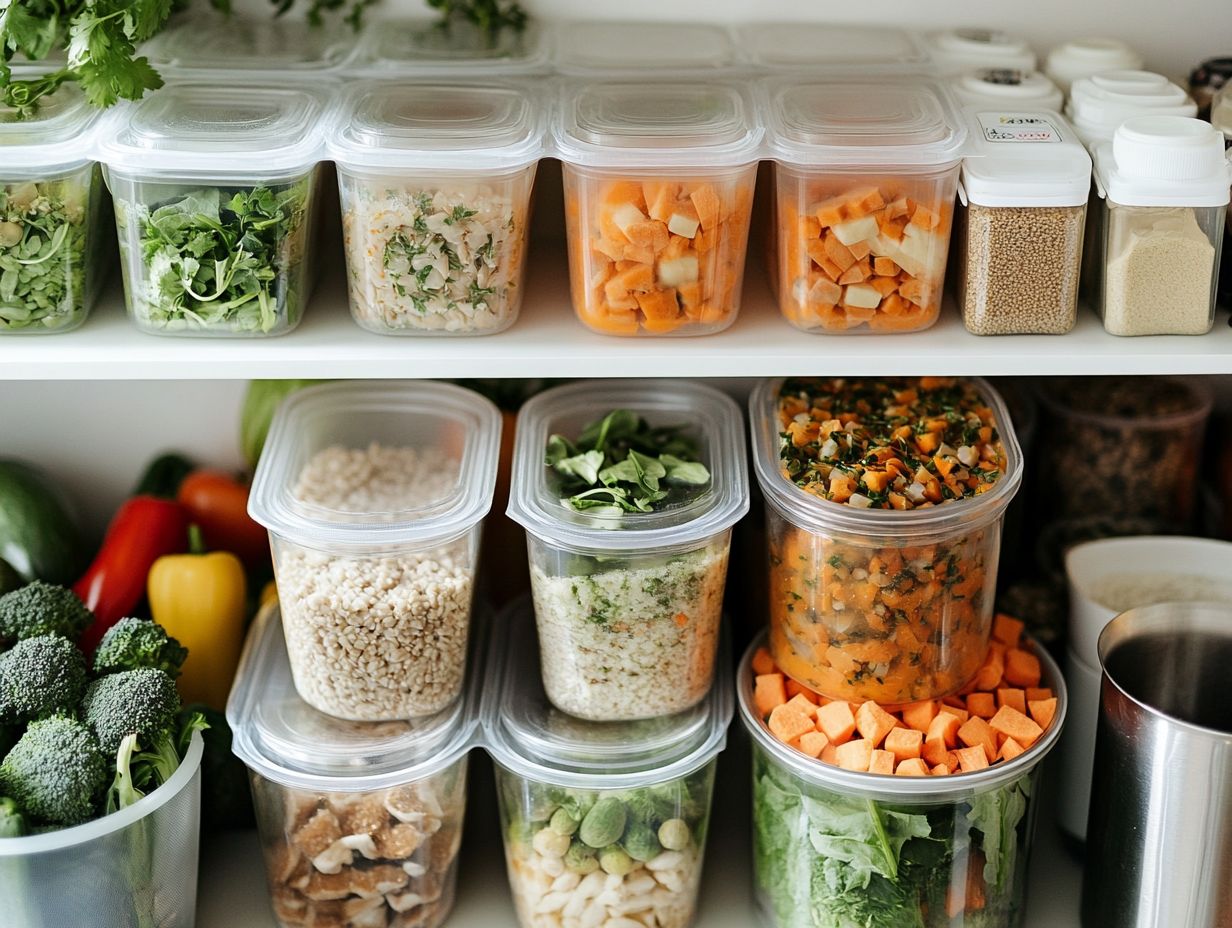Are you considering making homemade cat food for your feline friend? Many cat owners are turning to home-cooked meals to ensure their pets receive the best nutrition possible.
This article explores the benefits of homemade cat food, the essential nutrients your cat needs, and step-by-step guidelines for preparing and storing meals safely, including tips on cat food storage and using an automatic pet feeder.
With some simple tips and quality ingredients, you can provide a delicious and healthy diet that your cat will love, whether it’s homemade, fresh cat food, or even frozen raw food.
Key Takeaways:
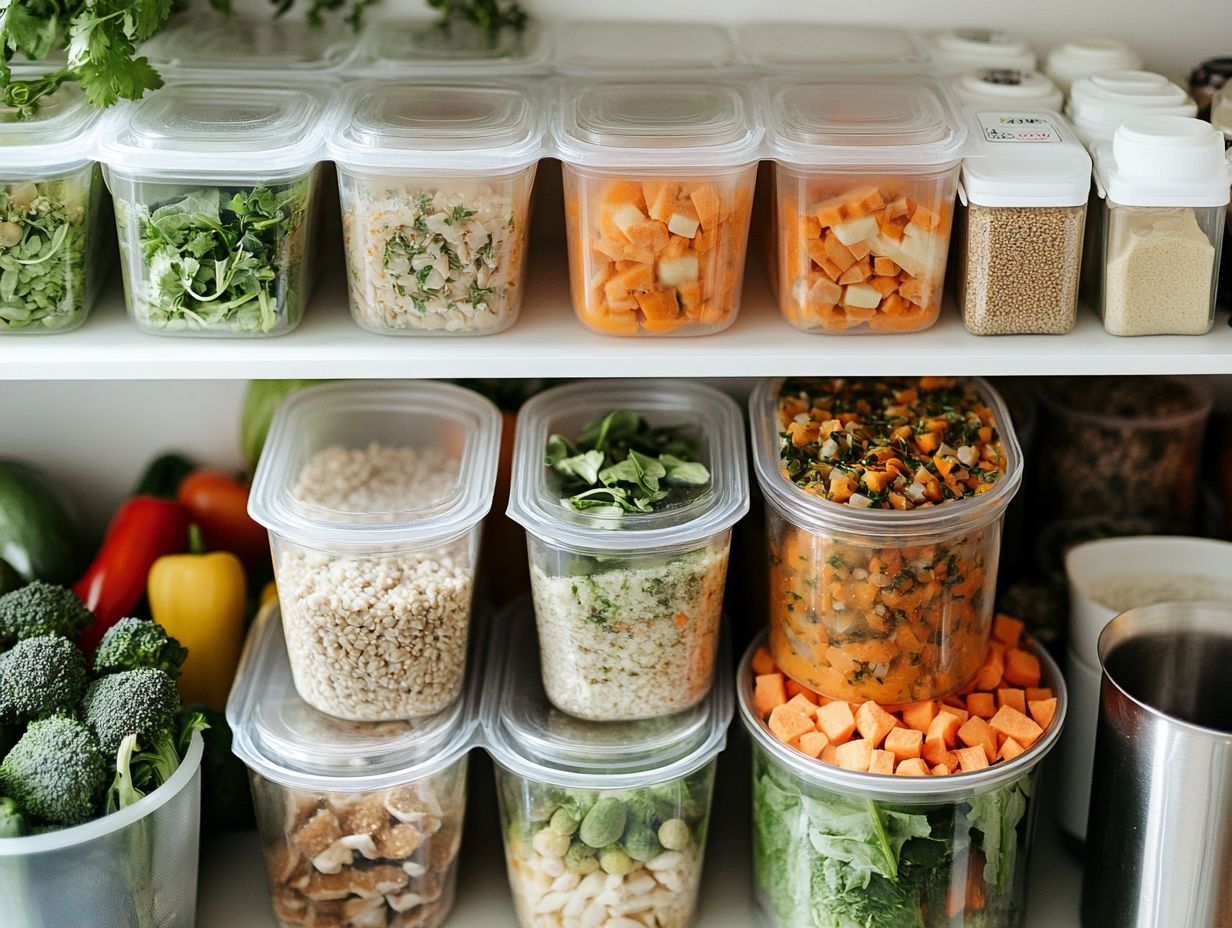
- Choose high-quality ingredients for homemade cat food, including protein, fat, carbohydrates, vitamins, and minerals.
- Cook homemade cat food thoroughly and allow it to cool before storing in airtight containers labeled with the date, following pet food storage guidelines.
- Store homemade cat food in the fridge or freezer and keep a rotation schedule to ensure freshness. Frozen homemade cat food can last longer than fresh, especially when considering nutritional quality.
- Homemade diets often require supplements to ensure a complete nutritional profile, particularly for key nutrients like taurine.
- Consult with a veterinarian before making significant changes to your cat’s diet.
Why Make Homemade Cat Food?
Homemade cat food enables pet owners to provide their cats with complete and balanced meals tailored to their specific health needs. Veterinary nutritionists, such as Lisa A. Pierson, DVM, offer guidance through her website, CatInfo.org, helping pet owners create nutritious recipes that emphasize high-quality ingredients like meat, organs, bones, and egg yolks.
Preparing homemade cat food can reduce the health risks associated with commercial cat food, which often contains artificial flavors and ingredients that do not meet the dietary requirements of obligate carnivores, such as those found in dry and wet cat food.
What Are the Key Nutrients for Cats?
Understanding the key nutrients essential for feline health is crucial for anyone considering feeding their cats homemade meals, which include raw cat food and cooked cat food, as these nutrients play a significant role in overall well-being.
Cats are obligate carnivores that thrive on a diet rich in protein, fat, and specific carbohydrates, along with vital vitamins and minerals such as taurine, vitamin E, and B-complex vitamins, according to experts like Karen Becker, DVM and Jennifer Coates, DVM.
The nutrient ratios, especially the calcium-to-phosphorus ratio, are important for crafting meals that support optimal health and energy levels in cats, as emphasized by Cailin R. Heinze from the Mark Morris Institute. It is recommended that adult cats receive a protein percentage of at least 26-30% of their diet, which may vary for kittens, senior cats, or those with specific health conditions.
1. Protein
Protein is one of the three primary macronutrients, alongside carbohydrates and fats, and serves as a crucial building block for every part of a cat’s body. It is the primary source of the components needed for muscle development, immune function, and overall energy levels in animals. To thrive, cats require a diet rich in animal protein. Balanced diets for cats, including homemade recipes, should feature high-quality protein sources such as raw or cooked chicken, turkey, and rabbit.
It’s important to recognize the differences between raw and cooked protein sources. Raw proteins retain natural enzymes and nutrients that cooking can destroy; however, they also carry a risk of bacterial contamination, which cooking can significantly reduce. Feeding cats appropriately, including the use of homemade recipes, should always be done in consultation with a veterinarian. Sources of raw meat should always come from reputable suppliers to minimize risks.
Cats, like other felines, have specific amino acid requirements, including taurine. They cannot synthesize enough taurine on their own, so it must be obtained through their diets. Taurine is essential for heart and eye health. These factors underscore the importance of ensuring that cats receive sufficient animal-based protein as a key component of their diets, including in homemade recipes.
In 2016, Rozenberg et al. published a review in the journal Animals on the nutrient requirements of cats, highlighting the significance of protein in a cat’s diet. Protein provides essential amino acids and nitrogen necessary for synthesizing new proteins and body tissues. Furthermore, proteins serve as precursors for enzymes vital for metabolic processes and hormones that regulate various bodily functions. In the absence of carbohydrates and fats, proteins can also be utilized as an energy source.
Signs of Spoilage in Homemade Cat Food
It is essential to check for freshness in homemade cat food. Signs of spoilage can include:
- Off or sour smells
- Discoloration or an unusual texture
- Mold growth
- Excessive separation of ingredients
When in doubt, discard the food to ensure your cat’s safety.
Additionally, in 2016, the Feline Nutrition Foundation published a review in the Journal of Feline Medicine and Surgery that assessed the macronutrient, vitamin, and mineral needs of domestic cats. This review evaluated various studies estimating the minimum and maximum energy percentages that cats derive from protein in their diets, along with the amino acid requirements for homemade cat food recipes. According to AAFCO and WSAVA guidelines, the protein percentage in the dry matter content of homemade cat food should be at least 26% for adult maintenance and 32% for growth and reproduction. To ensure a complete amino acid profile, homemade cat food recipes should incorporate a variety of protein sources.
2. Fat
Fat plays a crucial role in a cat’s diet by providing essential fatty acids that promote skin health, enhance coat quality, and maintain energy levels. Incorporating sources of healthy fats, such as wild salmon oil, into homemade cat food can improve its palatability and offer numerous health benefits. However, it should be used in moderation, and it is advisable to consult a veterinarian for appropriate dosages based on individual cat needs.
Key healthy fats, including omega-3 and omega-6 fatty acids, are vital for a cat’s overall well-being. Omega-3 fatty acids, primarily sourced from fish oil, are effective in controlling inflammation and supporting healthy skin, while omega-6 fatty acids contribute to a healthy coat and cellular structure.
By ensuring that cats have adequate access to these fatty acids, pet owners can promote their cats’ overall health, maintain a shiny coat, and sustain energy levels throughout the day. Achieving a proper balance of these essential fatty acids is crucial for a cat’s metabolism and energy.
3. Carbohydrates
Cats are obligate carnivores and require very few carbohydrates; however, they can benefit from small amounts of digestible carbohydrates that provide dietary fiber and energy. Ingredients like psyllium husk powder can promote digestive health and regularity in homemade cat food recipes. The following points about feline dietary requirements emphasize that additional carbohydrates should be minimized:
- Proteins: Cats need protein from animal sources to thrive. Essential amino acids derived from animal tissue are critical for a cat’s growth, development, and overall health. They cannot survive on plant proteins alone.
- Carbohydrates: The carbohydrates needed by a cat’s body are derived from amino acids, so the majority of their diet should consist of proteins and fats rather than carbohydrates. Cats do not produce insulin, which is essential for carbohydrate metabolism, indicating that they have no need for additional carbs in their diet. Overconsumption of carbohydrates can lead to health issues, such as obesity and diabetes, especially in predisposed cats.
Certain carbohydrates, such as pumpkin or sweet potatoes, can be beneficial due to their fiber content, which aids digestion and contributes to overall gut health. These ingredients are also excellent sources of vitamins and can be easily incorporated into homemade meals. It’s important to ensure the quality of carbohydrates used, as some ingredients may not be safe or beneficial for all cats.
Including these safe and appropriate carbohydrates can help create a balanced diet that aligns with a cat’s carnivorous nature, allowing cat owners to prepare meals that meet both energy requirements and digestive health needs.
4. Vitamins and Minerals
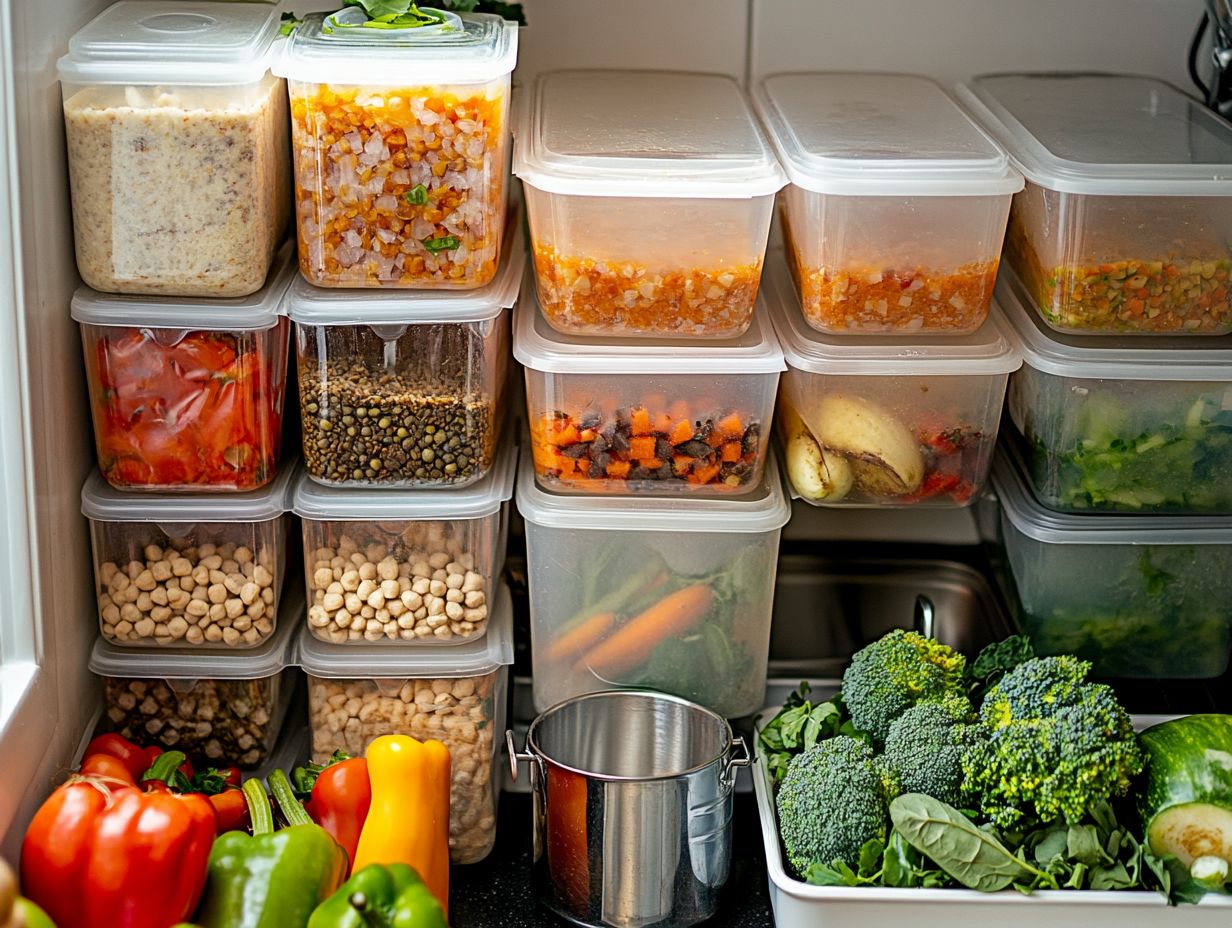
Vitamins and minerals are essential for regulating metabolism, immune health, and other bodily functions in cats. Key nutrients include Vitamin E, B-complex vitamins, essential fatty acids (omega-3 and omega-6), calcium, phosphorus, zinc, and selenium. The recommended daily allowances for these nutrients should be considered when preparing homemade cat food.
The B-complex vitamins play a significant role in metabolic regulation, while Vitamin E serves as an important antioxidant, working in tandem with selenium to support immune function and cell repair. Essential fatty acids, such as omega-3 and omega-6, are vital for maintaining a healthy coat and skin.
Calcium and phosphorus are crucial for bone health, and it is important to maintain a 1:1 ratio of these minerals in homemade cat food, as phosphorus supports bone growth and development, while calcium is essential for strong bones.
Nutrient-rich foods such as fish, liver, and certain vegetables can provide these important nutrients. Homemade cat food recipes can ensure that these vital nutrients are included by incorporating a variety of ingredients, such as lean meats, organ meats, vegetables, and supplements specifically designed for feline use. It is essential to use veterinarian-formulated supplements to meet any identified nutritional gaps.
When considering a homemade diet, it’s crucial to be aware of potential dangers associated with feeding raw diets, such as bacterial contamination. Always discuss such diets with a veterinarian to ensure safety and nutritional adequacy.
Finally, proper storage and handling of homemade cat food are essential to prevent spoilage and maintain nutrient integrity. Store meals in airtight containers and refrigerate or freeze to keep them fresh. Additionally, tailored diets may be necessary for cats with specific health conditions, reinforcing the importance of consulting with a veterinary professional for individualized dietary recommendations.
A deficiency in these essential nutrients (such as proteins, fats, vitamins, and minerals) can lead to impaired immunity, skin issues, and even developmental defects. For more information on ensuring your cat’s food is stored correctly, check out Storing Homemade Cat Food: Tips for Safety and Freshness.
How to Make Homemade Cat Food?
The process of making homemade cat food involves several key steps:
- Planning
- Preparation
- Cooking
- Storage
- Monitoring and Adjusting
Careful planning and execution are essential to ensure that the meals are tasty, nutritious, and meet the dietary needs of cats. Developing a meal plan that includes high-quality ingredients, using appropriate recipes, cooking according to specific requirements, and following proper storage guidelines are critical steps in meeting a cat’s nutritional needs.
These practices help to promote the long-term health and well-being of your pet, ensuring their dietary needs are met.
1. Choose High-Quality Ingredients
Choosing high-quality ingredients is essential for preparing nutritious homemade cat food that fulfills your cat’s dietary needs. Fresh sources of meat, organs, and bones ensure the food is nutrient-rich, significantly enhancing the overall quality of the meals.
Organic ingredients may offer benefits, but they do not automatically equate to superior nutritional quality; overall ingredient quality remains paramount. It is important to include various protein sources, such as chicken, beef, rabbit, and fish, in your cat’s diet, as each provides different amino acids and nutrients vital for their well-being.
Ethically sourced ingredients not only support animal welfare but also tend to be fresher, better aligning with your pet’s natural dietary requirements. All of these factors contribute to a higher likelihood of your cat enjoying a longer and healthier life.
2. Follow a Balanced Recipe
Homemade cat food should be prepared using a balanced recipe that includes all the essential nutrients required for a cat’s diet. Proven recipes from veterinary nutritionists such as Lisa A. Pierson, DVM and resources like CatInfo.org can help ensure optimal nutritional quality and variety.
A balanced meal may consist of lean meats such as chicken or turkey, along with essential fatty acids from wild salmon oil. It’s important to incorporate animal protein sources as well as suitable carbohydrates and fiber from vegetables like sweet potatoes or peas, possibly supplemented with taurine and vitamin E.
While many homemade recipes may provide adequate nutrition, it may be necessary to include one or more nutritional supplements to ensure the proper proportions of nutrients. Readers are encouraged to consult reliable resources or veterinary professionals to help formulate balanced diets, ensuring that their furry family members receive the care they need.
Disclaimer: Homemade diets should be created with veterinary guidance to avoid potential nutritional deficiencies, especially in cats with special dietary needs.
3. Cook Thoroughly
Cooking ingredients is a crucial step in making homemade cat food, as it eliminates harmful bacteria such as Salmonella and E. coli and ensures the food is safe for consumption. Properly preparing the ingredients not only reduces health risks but also enhances the digestibility of the nutrients provided.
Methods such as boiling, baking, and steaming are effective cooking techniques that ensure all components are thoroughly cooked. Boiling softens meats and vegetables, making them easier for cats to digest, while baking can create a flavorful dish that your feline will enjoy. Steaming is particularly beneficial because it minimizes the loss of essential nutrients that may be diminished through other cooking methods. Avoiding overcooking is essential, as it can diminish nutritional value; using a food thermometer can ensure safe cooking temperatures.
Raw food poses significant health risks, such as bacterial infections, if not handled properly, making it vital to adhere to these safety guidelines for both health and nutritional purposes.
4. Allow to Cool before Storing
It is essential to cool homemade cat food completely after cooking before storing it, as this helps prevent the growth of harmful bacteria and ensures food safety. Proper cooling techniques also help maintain the nutritional quality of the ingredients used.
One effective method for speeding up the cooling process is to place the food in shallow containers. Additionally, leaving the food in a well-ventilated area or using a fan to circulate air can further enhance cooling efficiency. It is also crucial to refrigerate the food within two hours after cooking to prevent bacterial growth.
5. Recognizing Spoilage
Cat owners should be aware of signs of spoilage in homemade cat food, which may include unpleasant odors, discoloration, or a slimy texture. If any of these visual cues or smells are detected, it is best to discard the food to ensure the safety of your pet.
6. Monitor Health and Weight
When implementing homemade diets, it is important for cat owners to monitor their cat’s health and weight regularly. Referencing feline obesity guidelines can provide valuable insights into maintaining a healthy weight for your cat.
Lastly, always consult with a veterinarian before making significant dietary changes, especially for cats with underlying health conditions like kidney disease or diabetes.
Once the food is fully cooled, it is important to store it in airtight containers to minimize exposure to air and prevent moisture buildup. Labeling containers with preparation dates will assist pet owners in ensuring the food is used before it spoils.
By following these best practices, pet owners can support their cats’ health by providing fresh, nutritious food that is properly preserved. However, it is crucial to consult with a veterinarian before making homemade cat food, especially for cats with special dietary needs (e.g., kidney disease, diabetes).
What Are the Best Storage Practices for Homemade Cat Food?
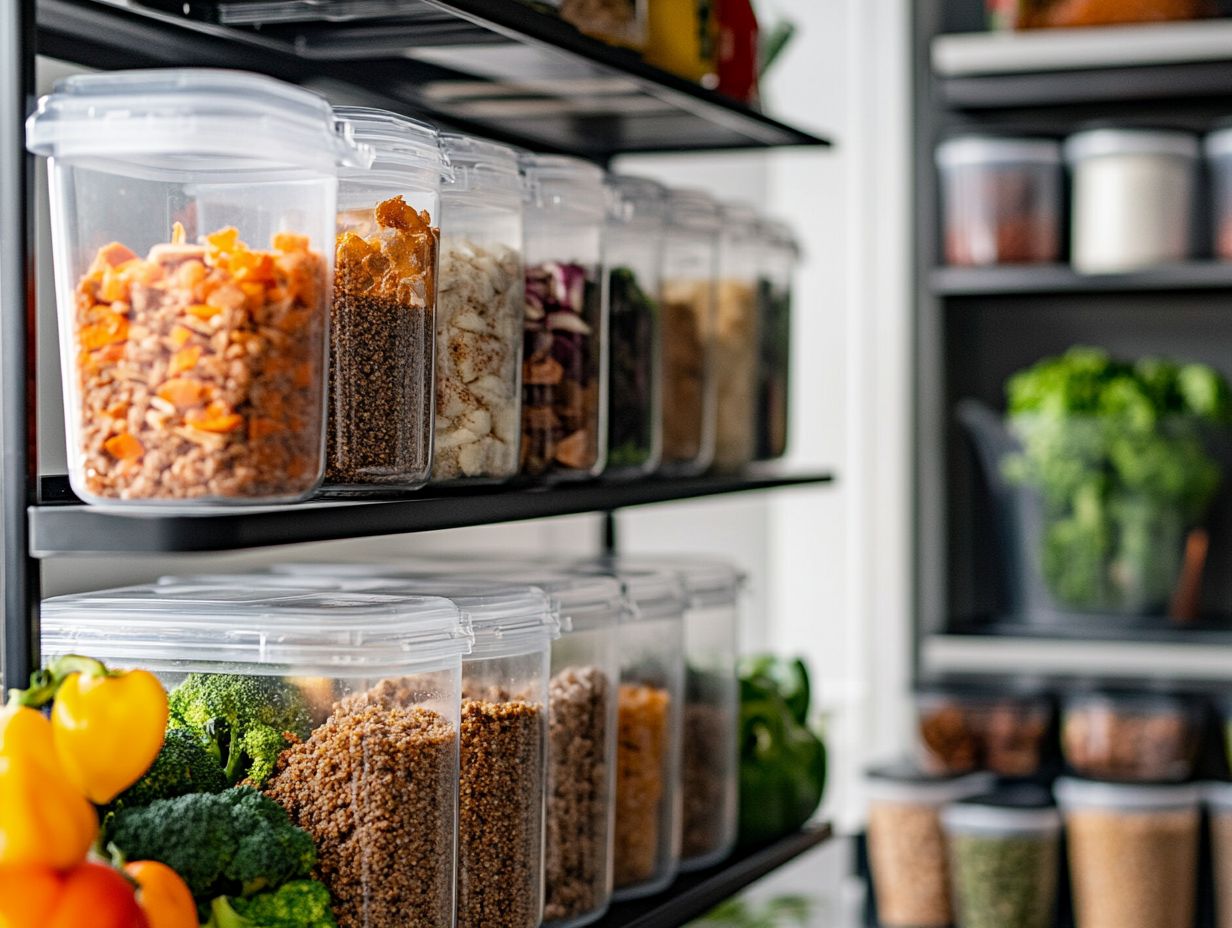
Storing homemade cat food properly is essential for maintaining its nutritional quality and ensuring your cat’s safety. Utilizing airtight containers, labeling and dating all stored items, and implementing a rotation schedule for food in the fridge or freezer are effective strategies for managing your cat’s meals while minimizing waste.
It is important to note that homemade diets can lead to potential nutritional deficiencies. Cats have unique dietary requirements, being obligate carnivores; thus, it is essential to include animal-source proteins. Consult veterinary guidelines such as AAFCO and WSAVA for nutritional adequacy and consider necessary supplements if needed, ensuring to adhere to safe dosage information.
1. Use Airtight Containers
Airtight containers are essential for storing homemade cat food, as they help keep the food fresh and protect it from external elements. Proper sealing extends the shelf life and preserves the quality of the food.
These containers can be made of glass, plastic, or stainless steel, each with its own advantages and disadvantages. Glass containers do not absorb odors or stains and are easy to clean. Plastic containers tend to be lighter and more affordable, while stainless steel is durable and resistant to rust.
To ensure optimal storage, food should be scooped out with a clean utensil to prevent moisture from entering, and the container should be tightly closed after each use.
2. Label and Date the Containers
Labeling and dating containers of homemade cat food is crucial for tracking freshness and ensuring food safety. Knowing the date of preparation helps you monitor when to serve the food to your pet and how quickly it should be used up to prevent spoilage. This aligns with proper cat food storage practices.
Along with the preparation date, the label should include information about the types of ingredients used and any special dietary needs. This practice allows you to track your cat’s nutrition and clearly marks any ingredients that need to be substituted or that could cause allergic reactions.
Be cautious with human food ingredients, as some are harmful to cats, including onions and garlic. Here is a list of toxic ingredients to avoid: onions, garlic, chocolate, grapes, raisins, and certain artificial sweeteners (like xylitol).
Having an organized system for storing cat food containers facilitates meal planning, ensuring your pet receives a varied and balanced diet tailored to their specific needs throughout the week. Creating designated storage areas for different types of food not only simplifies meal preparation but also reduces the risk of cross-contamination, significantly enhancing your cat’s overall safety and health.
3. Store in the Fridge or Freezer
Homemade cat food should be stored in the fridge or freezer to prevent spoilage, maintain freshness, and ensure its nutritional quality for your cat’s health and safety. Proper pet food storage practices are essential.
In the fridge: Store homemade cat food at temperatures below 40°F, and use it within three days of preparation.
In the freezer: Meals can be frozen at 0°F or lower, and frozen cat meals can last for several months. The best method for thawing the food is to place it in the refrigerator overnight. Avoid thawing meals at room temperature, as this increases the risk of bacterial growth from pathogens like Salmonella and Escherichia coli. If a meal is not completely consumed after being thawed, it should not be refrozen.
4. Keep a Rotation Schedule
A rotation schedule is an effective strategy for managing the storage of homemade cat food, ensuring that older food is used first while prioritizing freshness. By adhering to this schedule, pet owners can minimize waste and guarantee that their cats receive only the highest quality meals.
This practice not only delivers nutritional benefits but also safeguards the cat’s health by reducing the risk of spoilage. Consuming food in the order it is prepared or purchased promotes optimal freshness, supporting the pet’s digestion and overall well-being.
Implementing such a schedule is straightforward: simply label containers with dates and position older supplies at the front. Over time, pet owners will find that this method streamlines feeding routines, enhances convenience, and ensures their furry friends enjoy a diet rich in high-quality ingredients, free from harmful bacteria and nutrient depletion.
How Long Can Homemade Cat Food Be Stored?
Proper storage of homemade cat food and its shelf life are essential considerations for pet owners who opt to feed their cats freshly prepared meals. It is also important to consult a veterinarian when preparing homemade cat food to ensure it meets your cat’s nutritional needs and safety.
The shelf life of homemade cat food depends on whether it is refrigerated or frozen. Guidelines suggest that it can last a few days in the refrigerator and several months in the freezer. For optimal safety, always use high-quality ingredients in homemade cat food, as this ensures it meets the nutritional needs of cats as obligate carnivores.
1. Fresh Homemade Cat Food
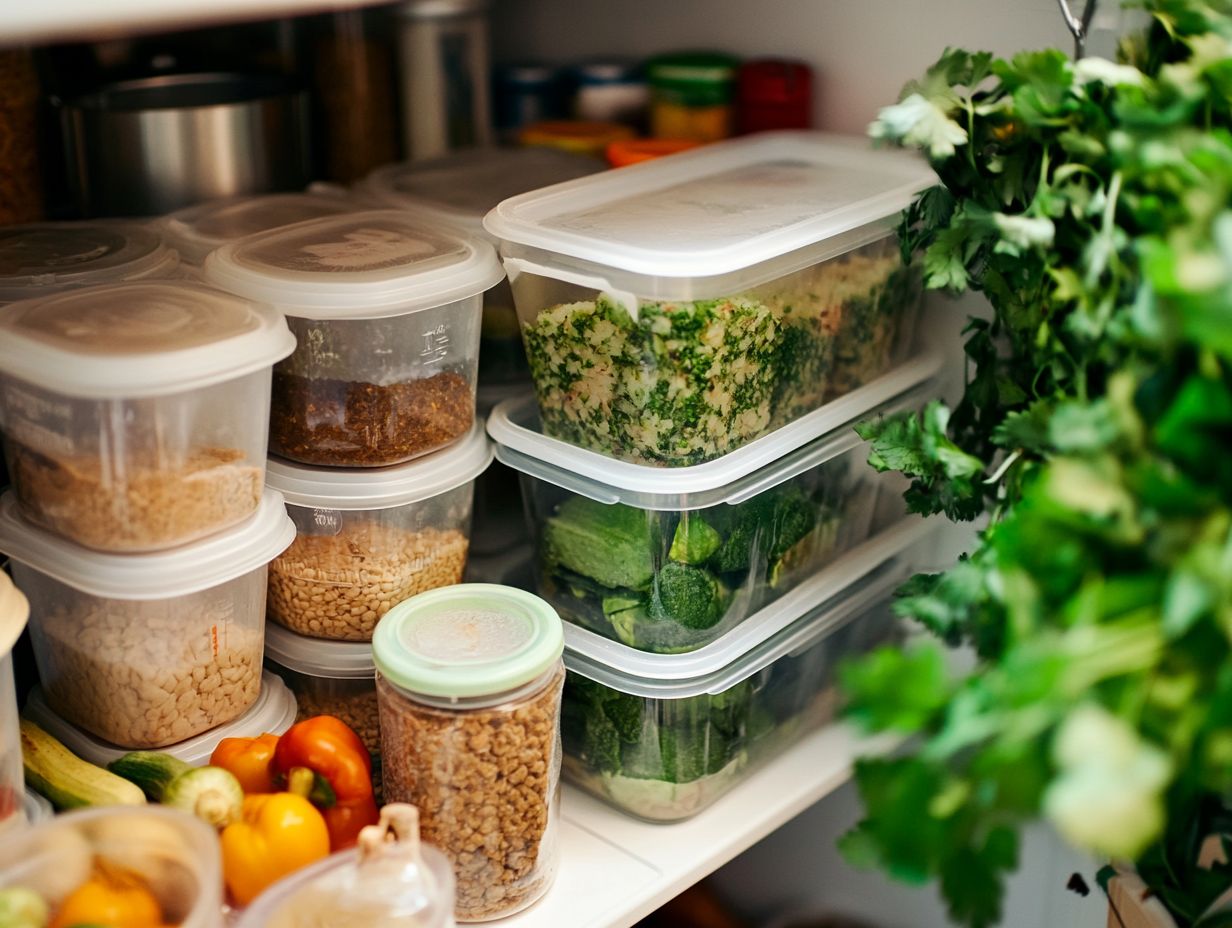
Fresh homemade cat food should ideally be consumed within three to four days when stored in the refrigerator to preserve its nutritional quality and prevent spoilage. It’s important to check the food for any signs of spoilage, including mold, changes in color, or taste. The food should be discarded if it exhibits questionable qualities.
The quality of fresh cat food is determined not only by its expiration timeframe but also by physical indicators such as color, texture, and odor. A strong smell or changes in color are clear signs that the food has spoiled, while softness or other abnormal textures may also indicate spoilage.
A practical solution is to label homemade meals with the preparation date, allowing for timely disposal after the designated period. Following these guidelines ensures that our beloved pets receive safe, nutritious meals that contribute to their overall health.
2. Frozen Homemade Cat Food
Frozen homemade cat food can generally be stored for up to six months without a significant loss in nutritional quality, but it’s best consumed within three months to ensure optimal nutrition. To ensure safety and prevent freezer burn, proper freezing techniques and airtight packaging are essential.
For optimal preservation, it’s advisable to portion the meals into smaller servings before freezing. Using freezer-safe bags or containers, along with appropriate labeling indicating the date and contents, can help maintain an organized inventory and facilitate easier defrosting. This is particularly important for raw cat food and cooked cat food, as they require different handling procedures.
When it’s time to serve, always inspect the meals for any signs of ice crystals or unusual odors, as these may indicate a decline in quality and affect the nutritional quality of the food. Regularly checking your inventory ensures that older meals are used first, promoting freshness and minimizing waste.
Frequently Asked Questions
What are the potential risks of not properly storing homemade cat food?
Improperly stored homemade cat food can lead to bacterial growth, spoilage, and potential foodborne illnesses for your cat. This poses health risks and can undermine the complete balanced meals you aim to provide.
How should homemade cat food be stored to ensure safety and freshness?
Homemade cat food should be stored in airtight containers, labeled with the date and type of food, and kept in the refrigerator or freezer. This is crucial for maintaining the essential nutrients like taurine, vitamin E, and B-complex vitamins, which are necessary for your cat’s health.
Can homemade cat food be left out at room temperature?
No, it is not safe to leave homemade cat food out at room temperature for an extended period of time. It should be refrigerated or frozen to prevent bacterial growth. Following proper cat food storage guidelines helps in preserving feline nutrition.
How long can homemade cat food be stored in the refrigerator?
Homemade cat food can typically be stored in the refrigerator for 3-4 days, but it is best to use it within 2-3 days for maximum freshness. This ensures your cat receives fresh cat food that meets their dietary needs.
Is it safe to freeze homemade cat food?
Yes, homemade cat food can be safely frozen for up to 3 months. Make sure to store it in a freezer-safe container and thaw it in the refrigerator before serving. This is particularly useful for frozen raw food, which should be handled with care to preserve its nutritional quality.
What common toxic ingredients should be avoided in homemade cat food?
When preparing homemade cat food, it’s crucial to avoid common toxic ingredients such as onions, garlic, and chocolate, as these can be harmful to your cat’s health.
Note: Sourcing ingredients with ethical and sustainability considerations while prioritizing your cat’s health and well-being is important.
Yes, homemade cat food can be safely frozen for up to 3 months; however, it’s essential to verify this with your veterinarian, as recommendations may vary. Store it in a freezer-safe container, and thaw it in the refrigerator before serving. Do not thaw at room temperature to prevent bacterial growth. This practice is particularly useful for frozen raw food, which should be handled with care to preserve its nutritional quality. Key nutrients like vitamins A, E, and certain B vitamins can be sensitive to storage conditions, and freezing can help maintain their integrity.
Are there any signs that homemade cat food has gone bad?
Yes, there are several signs that homemade cat food may be spoiled. Look for the following:
- Foul odor
- Changes in color or texture
- Signs of mold
- Unusual separation of ingredients
- Off-flavors
If you notice any of these signs, do not feed it to your cat. It is best to err on the side of caution and discard any questionable homemade cat food. Following guidance from experts like Lisa A. Pierson, DVM of CatInfo.org and Karen Becker of Feline-Nutrition can help you avoid these issues. Always consult your veterinarian before making homemade diets to ensure they meet your cat’s nutritional needs, especially if your cat has specific health conditions.
Additionally, consider sourcing your ingredients responsibly, ensuring they align with ethical and sustainability concerns while meeting feline nutritional requirements.
